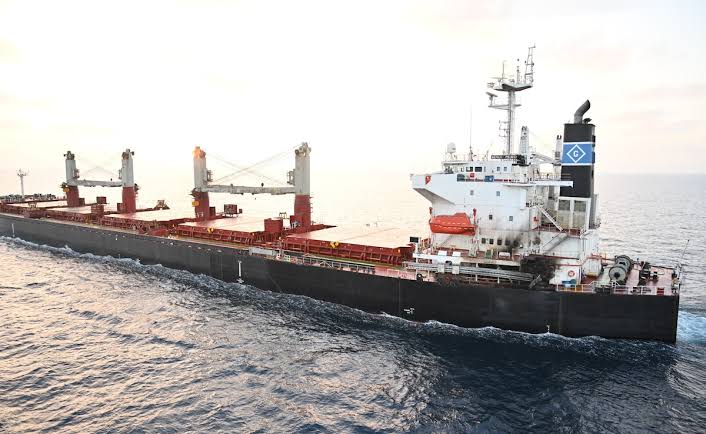The Red Sea, historically a vibrant artery of global trade, has become a flashpoint in recent months, plagued by a series of drone attacks targeting commercial vessels. In the latest incident, Indian Navy’s destroyer INS Visakhapatnam responded swiftly to a distress call from the Marshall Island-flagged MV Genco Picardy, struck by a drone on January 17th. While thankfully no casualties were reported, the attack highlights the escalating instability in the region and the crucial role of the Indian Navy in ensuring maritime security.
A Pattern of Attacks:
This drone strike adds to a disturbing trend. Since the Israeli offensive in Gaza, Houthi rebels in Yemen have been linked to numerous attacks on merchant ships across the Red Sea and Arabian Sea. Indian-crewed vessels like m.v. Chem Pluto and m.v. Sai Baba have also been targeted, raising concerns about the safety of Indian seafarers traversing these crucial shipping lanes.
Tensions Escalate:

The Houthi-led insurgency in Yemen, fueled by Iranian backing, has created a volatile security environment. The US-led coalition’s continued airstrikes targeting Houthi military installations aim to “degrade” their capabilities, but they also risk further inflaming tensions and fueling retaliatory attacks on commercial shipping. The recent US designation of Ansarallah (Houthis) as a Specially Designated Global Terrorist group adds another layer of complexity to the already intricate geopolitical landscape.
INS Visakhapatnam: A Beacon of Hope:
Amidst this escalating uncertainty, the Indian Navy’s prompt response to the MV Genco Picardy’s distress call offers a glimmer of hope. INS Visakhapatnam, deployed as part of India’s anti-piracy and maritime security patrols in the Gulf of Aden, swiftly intercepted the vessel and dispatched Explosive Ordnance Disposal (EOD) specialists to assess the damage and render the area safe for further transit. This decisive action showcases India’s commitment to ensuring the safety of seafarers and maintaining the free flow of trade in the critical Red Sea region.
Beyond Immediate Assistance:
The Indian Navy’s role extends beyond providing immediate assistance to distressed vessels. They have significantly enhanced maritime surveillance efforts in the Central and North Arabian Sea, deploying task groups and employing long-range maritime patrol aircraft and Unmanned Aerial Vehicles to maintain comprehensive maritime domain awareness. This proactive approach is crucial in detecting and deterring potential threats, safeguarding not only Indian interests but also contributing to the broader international effort to stabilize the region.
Gathering Evidence:
Furthermore, the Indian Navy’s collection of debris samples from attacked vessels marks a crucial step towards understanding the origin and perpetrators of these attacks. Through forensic analysis, they can potentially identify the type of drones used, trace their source, and hold the responsible parties accountable. This effort is vital in disrupting the cycle of violence and preventing future attacks.
Challenges and Uncertainties:
Despite the commendable efforts of the Indian Navy, the road to stability in the Red Sea remains fraught with challenges. The Houthi insurgency shows no signs of abating, and the US-led coalition’s military actions risk exacerbating tensions. Finding a diplomatic solution to the Yemeni conflict remains the ultimate key to lasting peace and maritime security in the region.
Indian Interests at Stake:
India’s economic interests are deeply intertwined with the stability of the Red Sea. It is a vital trade route for Indian exports, particularly hydrocarbons and agricultural products. Disruptions due to piracy or attacks can inflict significant economic damage. Furthermore, with a large Indian diaspora present in the Gulf region, ensuring safe passage across the Red Sea is a matter of national security for India.
Beyond Indian Waters:
The Indian Navy’s proactive role in the Red Sea extends beyond safeguarding its own national interests. India has emerged as a leading maritime power in the Indian Ocean region, committed to upholding international maritime law and ensuring the free flow of trade. Its contributions to anti-piracy patrols and its swift response to distress calls like that of the MV Genco Picardy showcase its growing responsibility and capabilities in maintaining maritime security on a global scale.
Also Read: Democrats Walk a Tightrope: Balancing the Prospect of a Trump Rematch with the Dangers of a Second Term
A Sea of Hope:
The Red Sea, currently a turbulent crossroads of geopolitical tensions, holds the potential to be a sea of hope and prosperity. The Indian Navy’s commitment to maintaining maritime security, coupled with diplomatic efforts towards a peaceful resolution in Yemen, can pave the way for a future where international trade flourishes and seafarers traverse these waters without fear. However, vigilance, decisive action, and international cooperation remain crucial in navigating the uncertain waters of the present and ensuring a more stable future for the Red Sea.

Can you be more specific about the content of your article? After reading it, I still have some doubts. Hope you can help me.